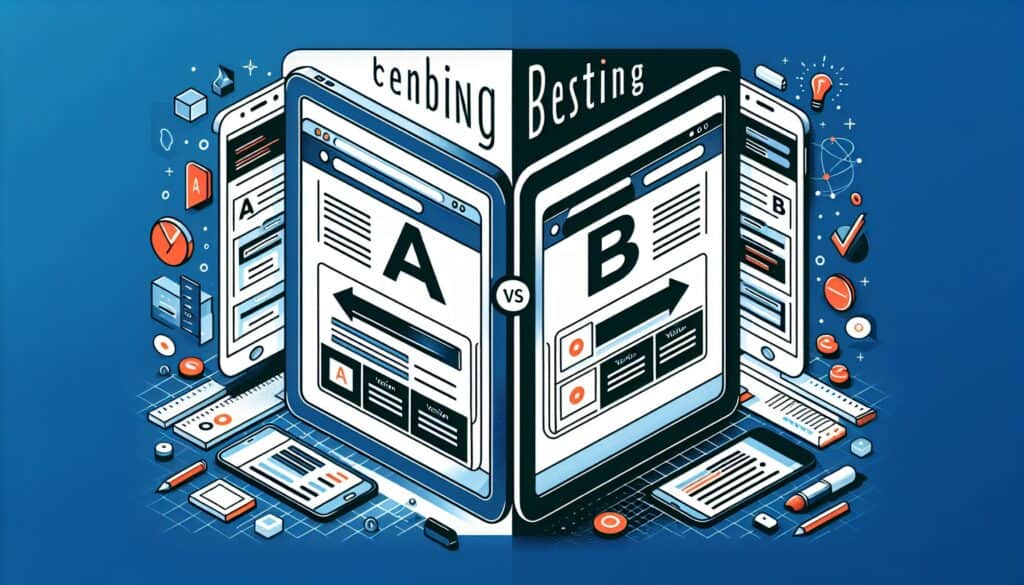A method of comparing two versions of a webpage, app screen, email, or other marketing asset (Version A and Version B) to determine which one performs better in achieving a specific goal (e.g., higher conversion rate, more clicks).
- Methodologies: Ergonomics
A/B Testing

A/B Testing
- A/B testing, Continuous Improvement, Conversion Rate, Digital Marketing, Iterative Development, Statistical Analysis, Testing Methods, User experience (UX), User Interface (UI)
Objective:
How it’s used:
- Users are randomly shown either Version A or Version B. Their interactions are tracked, and statistical analysis is used to determine if there is a significant difference in performance between the two versions for a given metric.
Pros
- Provides data-driven insights into what works best for users; Allows for iterative improvements based on evidence rather than intuition; Can lead to significant improvements in key metrics.
Cons
- Requires sufficient traffic/users to achieve statistically significant results; Testing too many variables at once can be confusing; External factors can sometimes influence results; Focuses on incremental changes, may not lead to radical innovation.
Categories:
- Customers & Marketing, Economics, Product Design
Best for:
- Optimizing web pages, app interfaces, email campaigns, and other digital experiences to improve user engagement and conversion rates.
A/B testing finds extensive application across various sectors, particularly in digital marketing, e-commerce, and software development, where businesses seek to enhance user experiences and drive higher conversion rates. In web design, this methodology is often employed during the early stages of user interface (UI) development, enabling designers and developers to understand user preferences in real time. Marketers frequently harness A/B testing in email campaigns to fine-tune subject lines, content, or call-to-action buttons, allowing them to identify which elements resonate most with their audience. Its utility extends to mobile application development, where it helps to evaluate different layouts or feature functionalities before launch. Participants in A/B testing typically include product managers, UX designers, data analysts, and developers, all of whom collaborate to design experiments, set performance metrics, and analyze results. Successful implementations rely on pre-defined hypotheses and well-structured test groups to ensure statistical validity. As businesses accumulate more data through iterative testing, they can implement informed decisions that lead to better customer satisfaction, higher retention rates, and increased revenue, establishing a robust feedback loop that continually refines product offerings based on empirical evidence rather than guesswork. Additionally, A/B testing can be adapted to various project contexts, whether launching new products, optimizing existing features, or exploring marketing strategies, providing companies with the flexibility to evolve in alignment with user needs and preferences while mitigating risks associated with major changes.
Key steps of this methodology
- Define the hypothesis and identify the key performance indicators (KPIs) to measure.
- Develop Version A (control) and Version B (variant) with distinct differences to test.
- Randomly assign users to each version using randomized allocation.
- Enable tracking mechanisms to monitor user interactions and relevant metrics.
- Run the experiment for a predetermined duration to ensure statistical validity.
- Apply statistical analysis methods to compare performance metrics of both versions.
- Determine if the results indicate a statistically significant difference.
- Make informed decisions based on the analysis results for iterative improvements.
Pro Tips
- Segment users based on behavior and demographics for targeted A/B tests, enhancing relevance and results accuracy.
- Conduct multivariate testing alongside A/B tests to identify interactions between multiple variables, providing deeper insights.
- Implement a robust tracking system that captures user paths and drop-off points, allowing for a comprehensive analysis of test results.
To read and compare several methodologies, we recommend the
> Extensive Methodologies Repository <
together with the 400+ other methodologies.
Your comments on this methodology or additional info are welcome on the comment section below ↓ , so as any engineering-related ideas or links.
Historical Context
1960
1980
1983
1990
1995
2000
2010
1950
1980
1980
1986
1994
1995
2000
(if date is unknown or not relevant, e.g. "fluid mechanics", a rounded estimation of its notable emergence is provided)














Related Posts
Musculoskeletal Discomfort Questionnaires
Multivariate Testing (MVT)
Multiple Regression Analysis
Motion Capture Systems
MoSCoW Method
Mood’s Median Test